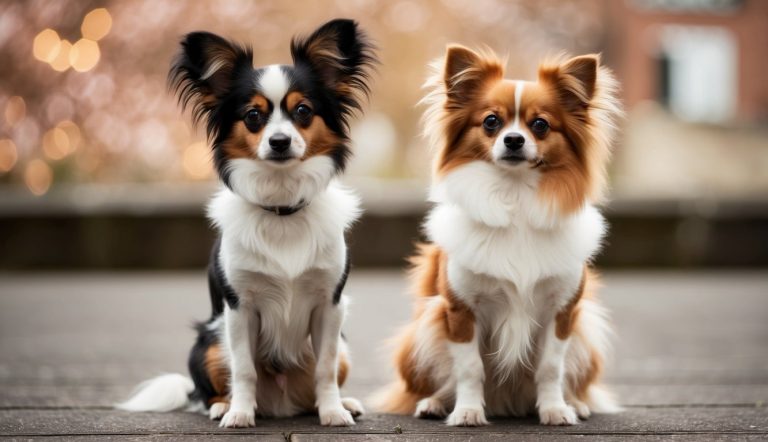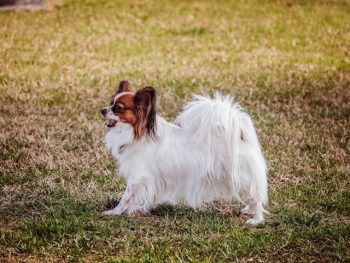The Papillon breed has a rich history spanning several centuries. Its origins trace back to European royalty, with the breed evolving through different names and varieties. Let’s take a look at the similarities and differences between the two breeds.
If you’re still on the market to buy a Papillon, PuppySpot currently offers a $300 discount using the code PUPPY300, just click the banner below!
Papillon and Phalene: Understanding the Varieties
- The Papillon comes in two varieties: the erect-eared Papillon and the drop-eared Phalene. Both share the same breed standard, differing only in ear shape.
- Papillons have upright ears with fringed hair, resembling butterfly wings. This feature gives the breed its French name, meaning “butterfly.”
- Phalenes have drooping ears, similar to other spaniel breeds. The name “Phalene” comes from the French word for moth.
- Both varieties can appear in the same litter, highlighting their close genetic relationship.
The Continental Toy Spaniel
- Before being called Papillons, these dogs were known as Continental Toy Spaniels. This name reflects their European origins and small size.
- Continental Toy Spaniels were popular among European nobility in the 16th and 17th centuries. You can spot them in paintings by famous artists like Titian.
- The breed’s appearance in art across Spain, France, and the Low Countries suggests it was well-established and valued.
- Their small size and elegant appearance made them ideal companions for aristocratic ladies.

Epagneul Nain: The French Influence
- In France, the breed was called Epagneul Nain, meaning “dwarf spaniel.” This name highlights its small size and spaniel-like qualities.
- French breeders played a crucial role in developing the Papillon we know today. They focused on refining the breed’s distinctive features.
- The shift from drop ears to erect ears happened gradually. By the late 1800s, the butterfly-eared variety became known as the Papillon.
- French influence extended to the breed’s temperament, developing its lively and intelligent nature.

Breed Characteristics and Standards
The Papillon dog breed has distinct features that set it apart. Its appearance and size follow specific standards for show dogs.
Defining the Papillon’s Appearance
- Papillons are small, elegant dogs with a fine-boned structure. They have a silky coat that comes in various colors paired with white. The fur around their eyes and ears must be colored, not white.
- Their coat is long and flowing, adding to their graceful look. Papillons have a friendly face with alert, dark eyes. Their expression is often described as intelligent and curious.
- These dogs move with a light, dainty action. Their overall appearance gives an impression of delicate beauty combined with an active, lively nature.
The Papillon’s Butterfly-Like Ears
- The most striking feature of the Papillon is its butterfly-like ears. These ears stand erect and are set high on the head. They’re covered in long fringes that create the image of butterfly wings.
- The ears are always moving, reflecting the dog’s thoughts and emotions. This constant motion adds to the breed’s lively and expressive personality.
- Some Papillons have drop ears instead of erect ones. This variety is called the Phalène, which means “moth” in French.
Size and Proportion: The Toy Breed’s Dimensions
- Papillons belong to the toy group of dog breeds. They’re known for their small size. The breed standard states that Papillons should be 8 to 11 inches tall at the withers.
- Their weight typically ranges from 3 to 6 pounds. Despite their small size, Papillons are hardy and well-proportioned dogs.
- A Papillon over 11 inches tall is considered a fault in show rings. Dogs over 12 inches are disqualified from competitions.
The Breed Standard for Show Dogs
The American Kennel Club (AKC) has set specific standards for Papillons in dog shows. These standards cover all aspects of the breed’s appearance and temperament.
Key points in the breed standard include:
- Butterfly-like ears
- Fine-boned structure
- Height between 8 to 11 inches
- Alert and friendly temperament
Papillons that meet these standards can compete in prestigious events. The breed has won “Best in Show” at the Westminster Kennel Club Dog Show. Judges look for dogs that closely match the ideal Papillon description. They assess factors like ear shape, coat quality, and overall proportions.

Grooming and Care
Papillons need regular care to stay healthy and look their best. Their coat and ears require special attention. Let’s look at how to groom them, watch for health issues, and keep them active.
Maintaining the Papillon’s Long Coat
- Papillons have long, silky coats that need regular brushing. Brush your Papillon’s fur 2-3 times a week to prevent tangles. Use a pin brush or slicker brush to remove loose hair.
- Pay extra attention to the ears and tail. These areas can mat easily. Trim the hair around your dog’s paws to keep them neat.
- Bathe your dog every 4-6 weeks. Use a gentle dog shampoo. Rinse well to avoid skin irritation.
- Papillons don’t shed much, but regular grooming helps control loose hair. Clip their nails every 2-3 weeks. Check and clean their ears weekly to prevent infections.
Health Problems and Lifespan Considerations
Papillons are generally healthy dogs. They can live 12-16 years with good care. But they may face some health issues.
Watch for:
- Patellar luxation (kneecap problems)
- Eye issues like cataracts
- Dental problems
Take your Papillon for regular vet check-ups. Keep their teeth clean with daily brushing. This helps prevent dental disease. Feed your pup a balanced diet. Keep them at a healthy weight to avoid joint stress. Ask your vet about supplements for joint health.
Exercise Needs for a Small But Active Dog
Papillons are small but full of energy. They need daily exercise to stay happy and healthy.
Aim for 30-45 minutes of activity each day. This can include:
- Short walks
- Playtime in a fenced yard
- Indoor games like fetch
Papillons enjoy dog sports like agility. These activities challenge their minds and bodies. Teach them new tricks to keep them mentally sharp. Be careful in hot weather. These dogs can overheat easily. Always provide fresh water. Watch for signs of tiredness during exercise.
Temperament and Social Traits
Papillons are known for their friendly and outgoing nature. These little dogs have big personalities that make them excellent companions and therapy animals.
The Sociability of Papillons
- Papillons love being around people. They’re alert, friendly, and affectionate. You’ll find them eager to greet visitors and make new friends.
- These dogs do well in social settings. They enjoy being the center of attention and will happily interact with strangers.
- Papillon puppies need early socialization to develop into well-rounded adults. Expose them to different people, pets, and situations from a young age.
Papillons as Companionship and Therapy Dogs
- The Papillon’s loving nature makes it an ideal companion dog. They form strong bonds with their owners and love being close to you.
- These dogs excel as therapy animals due to their gentle temperament. Their small size allows them to sit comfortably on laps, providing comfort to those in need.
- Papillons are sensitive to their owner’s emotions. They’ll often try to cheer you up when you’re feeling down.
Intelligence and Trainability
- Papillons are among the smartest dog breeds. Their quick minds make them easy to train. You’ll find they pick up new commands rapidly.
- These dogs thrive on mental stimulation. Provide puzzle toys and training sessions to keep their minds sharp.
- Positive reinforcement works best with Papillons. They respond well to praise and treats during training.
- Consider agility or obedience training to challenge your dog’s intellect. They excel in these activities.
Watchdog Abilities of the Butterfly Dog
- Despite their small size, Papillons make excellent watchdogs. They’re alert and attentive to their surroundings.
- Your Papillon will likely bark to alert you of strangers or unusual noises. This makes them good for home security.
- Keep in mind that their barking can become excessive if not properly managed. Early training can help control this behavior.
- Papillons are brave and won’t hesitate to stand up to larger dogs. However, supervise interactions to ensure their safety.

Considerations for Prospective Owners
Bringing a Papillon into your life requires careful thought. These small dogs have big needs in terms of care, companionship, and finding the right breeder. Choosing a name for your new pet is also an important step.
Living with a Papillon in an Apartment
- Papillons can do well in apartments due to their small size. They don’t need a big yard, but they do need daily exercise and mental stimulation.
- A short walk or indoor play session can meet their needs. These dogs may bark at noises, so training is key for apartment life.
- Papillons crave attention and can get lonely. If you work long hours, consider a dog walker or daycare. These smart dogs enjoy puzzle toys to keep them busy when you’re away.
Naming Your Papillon
- Papillons often get names inspired by their butterfly-like ears. Butterfly, Flutter, or Wing are popular choices.
- For male dogs, consider names like Charlie, Max, or Leo. Female Papillons might suit names like Bella, Luna, or Daisy.
- Short names work well for training. Your dog should respond quickly to its name. Avoid names that sound like commands you might use.
- Remember, this long-lived breed will have this name for many years. Choose something you’ll enjoy saying often.




